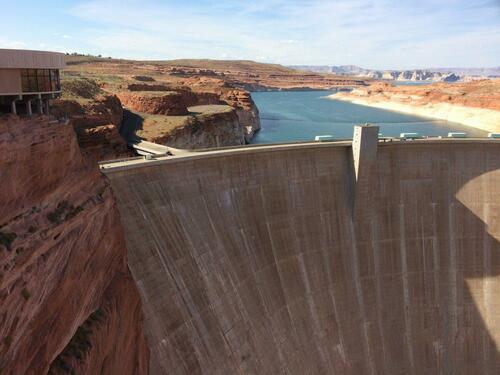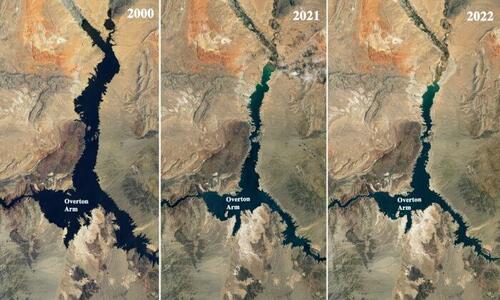Megadrought Threatening Millions Of Americans With Loss Of Water And Power
Authored by Katie Spence via The Epoch Times (emphasis ours),
The Colorado River Basin meanders through seven U.S. states and supplies water to Lake Powell in the Upper Basin and Lake Mead in the Lower Basin. In turn, these reservoirs deliver water and power to millions of Americans.
They’re also going dry.
Indeed, on Aug. 16, 2021, the Bureau of Reclamation issued the first Level One Shortage Condition in the Lower Basin when Lake Mead fell below 1075 feet.
Then, in March 2022, the bureau reported that Lake Powell fell below the target elevation of 3,525 feet for the first time since the 1960s.
Pointedly, these drops threaten hydropower generation and municipal water needs for 40 million Americans.
And while Congress has taken steps to address the flagging water supply, a 20-year megadrought and unsustainable allotments are hampering its efforts.
In 1999, Lake Powell averaged a water elevation of almost 3,681 feet, and Lake Mead was almost near capacity at 1,220 feet near the dam.
After more than 20 years of drought, the West has officially entered a megadrought (meaning 20 or more years), and Lake Powell’s water level is down almost 150 feet. Lake Mead’s water level is down nearly 176 feet.
Indeed, the period from 2000 to 2021 was the driest on record for many states in the West.
The United States Department of Agriculture (USDA) designated 63 out of 64 Colorado counties as natural disaster areas due to drought and declared natural disaster areas in several Wyoming counties.
In Mancos Valley, an area considered a Colorado agricultural utopia with cooler weather and “plenty” of water, streams ran at half the average flow, reducing water for hundreds of farmers and ranchers.
Moreover, headwaters for the Colorado River Basin start in Colorado and Wyoming, meaning the lack of water didn’t just affect the two states.
“Water conditions on the river depend largely on snowmelt in the basin’s northern areas [of Colorado and Wyoming],” states a Congressional Research Service report (CRS).
Still, it could probably pull through if the megadrought was the only problem facing the Colorado River Basin. Unfortunately, federal and state mismanagement compound the megadrought, driving the river to the brink of disaster.
Unsustainable Drains
In 1922, the Basin States of Colorado, Utah, New Mexico, Nevada, Arizona, and California established the Colorado River Compact to release water from the lakes based on basin storage conditions.
Specifically, under the compact, each basin is allocated 7.5-million-acre feet (MAF) per year—one-acre foot equals about 326,000 gallons—and a certain percentage goes to the Basin States based on water levels in the dams.
At its peak, Glen Canyon Dam on Lake Powell can store 26.2 MAF, and Hoover Dam on Lake Mead can store 26.1 MAF, according to CRS.

In 1944, the United States entered a treaty with Mexico to provide an additional 1.5 MAF from the basin to Mexico.
Markedly, at the onset of the compacts, federal and state governments assumed that river flows would average 16.4 MAF per year, states CRS. But that turned out to be a deeply flawed assumption.
From 1906 to 2020, the actual river flows averaged 13.9 MAF, but consumption and losses averaged approximately 15 MAF. Demand outpaced supply.
Drought and Hydroelectric Plants
According to the Department of Energy, hydropower is primarily used for ramping energy flexibility and represents less than 6.7 percent of U.S. electricity generation capacity.
In other words, if an area relies on solar and exceeds capacity, or the sun sets, hydropower can “ramp up” energy production quickly—hydropower provides approximately 40 percent of black start resources (restoring a power station to operation without relying on the external electric power transmission network after a total or partial shutdown).
It’s also considered one of the “cleanest” and “cheapest” forms of energy.
However, hydroelectricity generation depends on funneling large amounts of water from elevated heights through power plants typically found inside dams, according to the Water Resources Research Center, making significant river systems a vital resource.
Read more here…
Tyler Durden
Fri, 09/02/2022 – 21:40
via ZeroHedge News https://ift.tt/Sv9Fjcz Tyler Durden


